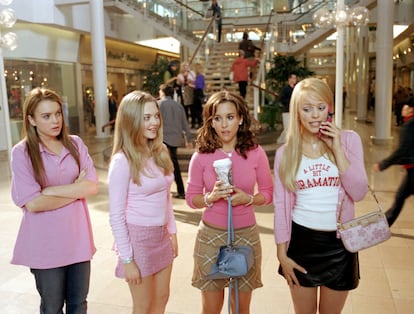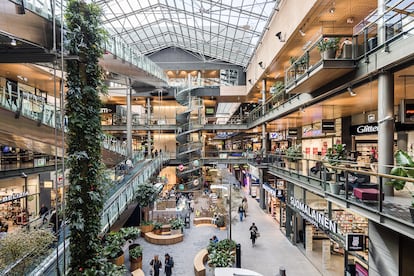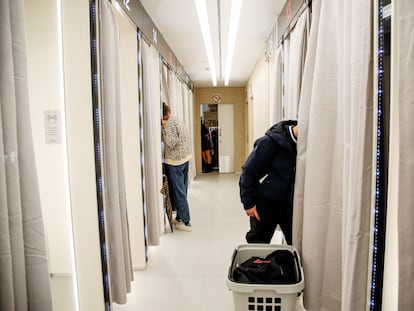The shopping mall is in crisis
An emblem of teenage social life thanks to movies, TV shows and music videos, the shopping center as we know it is changing. It is becoming a space for health and leisure

For years the epicenter of social life and a symbol of adolescence in the pre-social media era, the shopping mall is in crisis. Ignacio Zamora Carrillo is a real estate consultant who specializes in the purchase and sale of large properties. He has seen how some commercial enclaves have gone off the map. But despite the closures, he argues that the sector is merely experiencing a change in trends after years of growth. “In the 2000s there was a disproportionate boom, and malls were planned in areas that did not guarantee their viability.” He adds that “new centers that are being built aren’t megamalls, but smaller environments that combine open-air areas, restoration, natural light, easy walks and a more enjoyable environment.”
Ángel Zurdo Alaguereo, from the Applied Sociology department at the Complutense University of Madrid, says that “the mall has been a powerful agent of socialization, and not only among the youngest generations, with respect to consumer couture in recent decades, defining new behaviors and normalized practices that are part of the decline of the traditional market model and of small-scales commerce.” The mall has been a key element in articulating a lifestyle based on consumption, reflected in some of the most iconic movies of past decades. Many of the emblematic titles of the nineties and early two thousands have at least one iconic scene in a mall, the epitome of capitalist society. Cher Horowitz in Clueless spent more time shopping than at school. And who can forget the scene in Mean Girls when Lindsay Lohan’s character compares the teenagers preening in the mall with the wild animals she saw in Africa?
On the television phenomenon Stranger Things, set in the eighties, the mall appears as the nerve center of adolescent life, a reflection of the society in that era. In the world of music, Avril Lavigne presented herself to the world in the “Complicated” video as a troublemaker with a favorite activity: stirring things up at the mall. And the pop culture winks are not limited to the under-18 audience. The allure of the shopping oasis is highlighted in Scenes from a Mall, the 1991 movie starring Woody Allen and Bette Midler as a couple who walks through a mall as their relationship falls apart. There is also the iconic scene of Love Actually in which Alan Rickman’s cheating on Emma Thompson becomes clear while they make their Christmas purchases in the iconic Oxford Street Selfridges.
New times
The growth of clothing rentals, online shopping and custom-made fashion as an alternative to overproduction have shaped consumers’ behavior when it comes to visiting the mall. “The relationships between young people have become strictly digital. They don’t necessarily need a physical space to relate to each other, but they do it via social media, so malls have stopped being a key element in that aspect that has been so important for past generations,” explains Paco Lorente, a consumer behavior professor at ESIC Business School.
The Spanish association of shopping centers notes that in Spain, the peak of shopping malls openings was almost two decades ago. “The year 2003 marked a record, with the opening of 34 malls, and between 2000 and 2009 the rhythm of openings was intense. In recent years, openings have remained steady between five and eight projects each year.”
In 2020, a year marked by the Covid-19 pandemic, malls were completely emptied. That year, Billie Eilish chose a mall — California’s Glendale Galleria — to record her music video Therefore I Am. The singer moved across the screen in a deserted mall, with all its shops closed. While the sector has managed to overcome the effects of the lockdown, and even surpass its pre-pandemic numbers, the United States is home to dozens of abandoned malls. That is the basis of documentarian Dan Bell’s project Dead Mall Series, a collection of YouTube videos that document the decadence of the empty buildings. The dystopian air of the abandoned mall caught the attention of Taylor Swift five years ago, when the artist decided to film the video for … Ready For It? in Hawthorne Plaza, which has served as a set for dozens of movies and music videos in recent years.
Shopping malls have also been transformed into leisure centers with ballparks, giant spaces to celebrate birthdays and a large selection of toy libraries. The former sites of clothing and accessory stores have been converted into entertainment venues for children and teenagers.
From the ‘phygital’ format to health clinics next to clothing stores
It is estimated that Spain is one of the countries with the highest growth in online sales, according to the National Commission for Markets and Competition (CNMC), with the clothing sector being one of the most successful. How has this new form of consumption impacted places designed to enjoy physical shopping? In the opinion of Professor Ángel Zurdo Alaguero, from the Complutense University of Madrid, “the current ‘crisis’ of shopping centers is one of simple resizing in the context of the strong advance of e-commerce.” He adds that “these spaces for face-to-face consumption will continue to be key in the social concreteness of consumer practices, albeit with certain adaptations, like moving towards leisure practices or ‘experiences.’”
Will they adapt to the new needs of the digital-native younger generations? According to Paco Lorente, “shopping centers must adapt as society evolves and changes towards a dual reality. A mix between the digital and the physical that turns the experience of use and enjoyment into something memorable. Here comes into play a concept called ‘phygital,’ which aims to merge the advantages of the online and the physical, to make the most of both worlds and achieve a deeper state of happiness in the user.”
This hybrid that combines the best of the virtual world with the advantages of in-person shopping is reflected in recent openings, such as the WOW multi-brand store, located on Madrid’s Gran Vía since last year. Department stores are also reinventing themselves to attract the public and offer something beyond the digital experience.

Nor should we disdain the face-to-face format, as has been made clear by brands born in the heat of the Internet and with great success online, but capable of forming queues in their physical points. The sector is looking to move towards this kind of hybrid path, preferring to talk more about “integration” than “competition” with online sales: “A purchase can start online and finally materialize in a shopping center, or it can happen the other way around, with consumers using all the channels available to them,” Eduardo Ceballos points out.
From the point of view of real estate consultant Zamora Carrillo, another change that reflects the moment of transformation of the traditional shopping mall can be found in the square meters that are beginning to be occupied by spaces other than fashion and leisure within large stores. “Centers are introducing coworking spaces, aesthetic and health clinics and even student residences and coliving. In particular, clinics are gaining more and more weight and at some point it will be normal to see people who go for a check-up and then go shopping.” The new era of the shopping mall is already here.
Sign up for our weekly newsletter to get more English-language news coverage from EL PAÍS USA Edition
Tu suscripción se está usando en otro dispositivo
¿Quieres añadir otro usuario a tu suscripción?
Si continúas leyendo en este dispositivo, no se podrá leer en el otro.
FlechaTu suscripción se está usando en otro dispositivo y solo puedes acceder a EL PAÍS desde un dispositivo a la vez.
Si quieres compartir tu cuenta, cambia tu suscripción a la modalidad Premium, así podrás añadir otro usuario. Cada uno accederá con su propia cuenta de email, lo que os permitirá personalizar vuestra experiencia en EL PAÍS.
¿Tienes una suscripción de empresa? Accede aquí para contratar más cuentas.
En el caso de no saber quién está usando tu cuenta, te recomendamos cambiar tu contraseña aquí.
Si decides continuar compartiendo tu cuenta, este mensaje se mostrará en tu dispositivo y en el de la otra persona que está usando tu cuenta de forma indefinida, afectando a tu experiencia de lectura. Puedes consultar aquí los términos y condiciones de la suscripción digital.
More information
Archived In
Últimas noticias
Most viewed
- Sinaloa Cartel war is taking its toll on Los Chapitos
- Oona Chaplin: ‘I told James Cameron that I was living in a treehouse and starting a permaculture project with a friend’
- Reinhard Genzel, Nobel laureate in physics: ‘One-minute videos will never give you the truth’
- Why the price of coffee has skyrocketed: from Brazilian plantations to specialty coffee houses
- Silver prices are going crazy: This is what’s fueling the rally











































